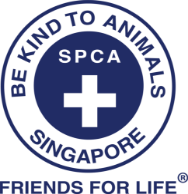High Rise Syndrome
Save Our Cats From Falling

High Rise Syndrome (HRS) is when an animal suffers injuries due to having fallen from height. Often, it is unintentional and happens because of slipping or losing their footing. Falling from as low as the second floor can cause severe injuries and trauma, or even death.
If you think the chances of your pet falling from height are low, think again! At SPCA, we receive at least five cases of Feline High Rise Syndrome per week, with at least half dying on impact. Five cases per week result in about 260 cases, with 130 fatalities, each year. These are just the cases that SPCA sees, and we predict that the overall data could be much higher. The SPCA strongly advocates that pet owners, especially cat guardians, should mesh their windows to avoid such accidents.
What happens when an animal falls from height?
The classic triad
HRS typically occurs in areas or homes where windows or balconies are not meshed. It is especially a concern in highly urbanised Singapore, where most of us live in high-rise apartment buildings. An animal that has fallen from a height typically presents with bleeding from the nose and mouth, cleft palate, and pneumothorax – known as the classic HRS triad. The impact of the fall causes a longitudinal palate fracture resulting in an abnormal opening on the roof of the mouth (cleft palate) and consequently an inability to eat or drink normally. Similarly, the trauma of the fall results in pneumothorax – air trapped between the lungs and chest wall. This prevents the lungs from inflating normally, resulting in lung collapse and death.



“Invisible” injuries On top of the HRS triad, common injuries include chest and respiratory injuries, head and facial injuries, limb fractures, and internal bleeding. The severity and type of injuries depend on the height of the fall, the position of the fall, and their landing (e.g. surface, position).“Cats always fall on their feet” is just a myth. When cats fall, they often land with their feet splayed apart, resulting in a whole range of blunt force and orthopaedic injuries. The higher the height that an animal falls from, the less likely the animal would survive. While the survival rate averages around 80-90%, many HRS studies exclude animals that were found dead on arrival. It is also important to note that survival chances increase drastically if immediate medical intervention is provided.
Mesh up, save lives Animals don’t choose to jump from heights; falling is unintentional and accidental. While they are instinctively aware of height hazards, a simple distraction such as a bird or a loud sound can cause them to slip and lose their footing. It is a pet guardian’s responsibility to keep the animals safe and remove all possibilities of them falling victim to HRS.
The most important consideration when installing mesh for your home would be that it is secure enough to not give way when your animal runs into it at full force. We recognise that budget and aesthetic appeal are common concerns that pet owners may have. Here are different ways you can safely secure your home for your furry ones – whilst keeping budget and aesthetics into consideration!





Unacceptable Mesh Options
When considering the various mesh options for your home, it is vital that the mesh should be able to withstand an animal running into it at full force, without breaking or coming apart.
A magnetic mesh isn’t strong/secure enough to withstand the weight/strength of an animal when it pushes through.
How you can help our animals

Pet guardians
Mesh your windows, doors, and balconies! Help stop the misconception that pets will only fall if they jump. Just like humans, every animal is susceptible to falling if they lose their footing. By meshing one’s home, pet guardians greatly reduce the chances of their pets falling victim to HRS.
Community feeders
Never feed community animals above the ground floor. We do not want these animals to develop a habit of exploring the higher levels, as it will increase the chances of them falling from height and becoming a nuisance to neighbours.
The responsibility of keeping our animals safe doesn’t stop at pet guardians or community feeders. You can also help to spread awareness by sharing the dangers of not meshing one’s house and responsible community animal feeding. Let’s do our part as a community, mesh up and save lives!
UPDATED APRIL 2023
